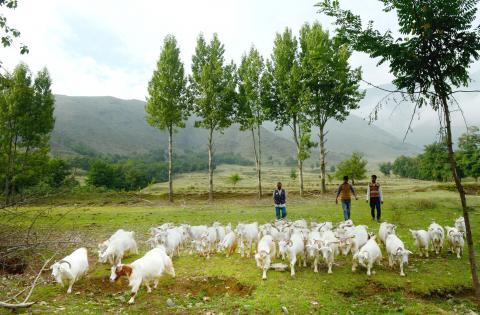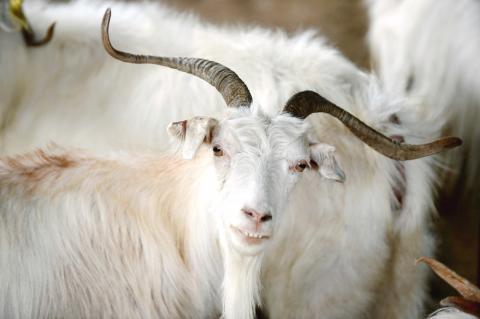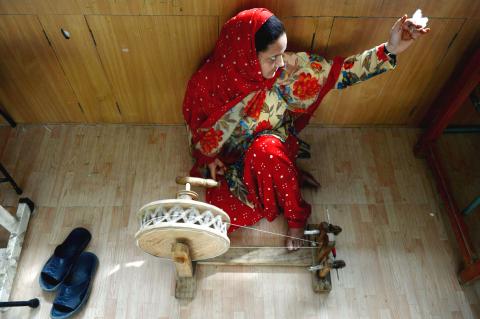In his two-room wooden house high in the beautiful Grace Valley in Pakistani Kashmir, Hidayat Ullah weaves at a manual paddle loom. Asked how he learned the craft, he gestured to an old man coughing on a bed.
“I got this skill from my father, but now my son is not taking up this profession. He prefers to work in the fields and sometimes also works as a laborer — it’s better money than the loom,” Ullah said.
Weavers have produced exquisite shawls in Kashmir for centuries, but their craft risks dying out in the face of cheap foreign imports and a young generation uninterested in mastering the skill.

Photo: AFP
Kashmir gave its name to the soft cashmere wool that commands sky-high prices in the West, but in Ullah’s village there are now only 10 paddle looms — known as khadis — where there were once 100.
Cashmere scarves and sweaters sell for hundreds of dollars in the developed world, but Hidayat Ullah takes only 3,000 Pakistani rupees (US$30) for the 15 days’ labor needed to make a shawl.
For centuries, the people of Grace Valley in the Pakistan-administered part of the Himalayan territory lived off their livestock, taking their animals up to high pastures in summer and bringing them down in September to shear them and spin the wool.

Photo: AFP
As snow blanketed the valley for the long months of winter, villagers confined indoors wove shawls, embroidering colorful patterns by hand before selling them in the spring.
However, demand among locals is collapsing.
“A hand-woven shawl costs 10,000 rupees, while you can get the same kind of shawl in the markets for 2,000 to 3,000 rupees,” weaver Zeenat Bibi, 32, said.

Photo: AFP
Bibi makes shawls with her father-in-law, but said no one else in her family wants to learn.
“I have a 10-year-old daughter who asks me why I waste my time doing this strange old job,” she said.
In the past, the isolation of the area helped local craftsmen as it was difficult to bring in goods from outside. Now, as communications open up, things are changing.
“These days second-hand clothes with new designs, good material and at cheaper prices are available, so they want to buy these and this old tradition is diminishing day by day,” said Fatima Yaqoob, a lecturer at the Arts and Cultural University of Azad Kashmir.
Government help is needed to modernize the industry — in particular to switch from manual to power looms — and encourage more people to go into it, she said.
In India, the government has stepped in to minimize the impact of similar problems affecting the traditional artisans who make beautiful shawls from special wool from the Pashmina goat.
It has secured a WTO Geographical Indication (GI) mark for the fabric and the process of shawl-making and set up a testing laboratory in Srinagar, the capital of Indian-administered Kashmir.
Pashmina goats are reared by nomads in the Changthang area of Indian Kashmir’s Ladakh at an altitude of more than 4,267m, where winter temperatures can plummet to minus-50oC.
The finest Pashmina wool is hand-spun into shawls, usually by women. Artisans then embroider them with intricate designs for a finished product that can cost thousands in the West.
Thousands of Indian Kashmiris are in the Pashmina trade, but scarce raw materials and an explosion in fakes worries artisans and traders, and many have quit the profession.
“The term Kashmir Pashmina is being misused by very many people around the world,” said M. S. Farooqi, who heads the Craft Development Institute in Srinagar.
“The craft of Pashmina making has such a historical context, exquisiteness and uniqueness that it is a coveted product worldwide ... and GI will help bring it back to the people and the region it belongs to,” Farooqi said.
However, the younger generation in Ladakh are abandoning the Pashmina trade for jobs with the government or construction.
Last winter, about 25,000 Pashmina goats perished in Changthang in unusually cold weather when their fodder froze under a thick, icy layer of snow and land routes to the area were cut off for weeks.
Scientists at the Sher-i-Kashmir University of Agricultural Sciences and Technology in Kashmir last year succeeded in making a clone of the Pashmina goat called Noori. The aim is to increase productivity of the Pashmina yielding goats and to send male clones into the environment to breed naturally.
Experiments have shown that the Pashmina goat can survive at lower altitudes, but does not produce the same quality of wool.
However, it is unclear if science can stop the market trends.
“Most buyers find it difficult to distinguish between a fake and a genuine Pashmina shawl,” said Mohammad Sadiq Wani, a trader and exporter of Kashmiri crafts.

Leading Taiwanese bicycle brands Giant Manufacturing Co (巨大機械) and Merida Industry Co (美利達工業) on Sunday said that they have adopted measures to mitigate the impact of the tariff policies of US President Donald Trump’s administration. The US announced at the beginning of this month that it would impose a 20 percent tariff on imported goods made in Taiwan, effective on Thursday last week. The tariff would be added to other pre-existing most-favored-nation duties and industry-specific trade remedy levy, which would bring the overall tariff on Taiwan-made bicycles to between 25.5 percent and 31 percent. However, Giant did not seem too perturbed by the

Foxconn Technology Co (鴻準精密), a metal casing supplier owned by Hon Hai Precision Industry Co (鴻海精密), yesterday announced plans to invest US$1 billion in the US over the next decade as part of its business transformation strategy. The Apple Inc supplier said in a statement that its board approved the investment on Thursday, as part of a transformation strategy focused on precision mold development, smart manufacturing, robotics and advanced automation. The strategy would have a strong emphasis on artificial intelligence (AI), the company added. The company said it aims to build a flexible, intelligent production ecosystem to boost competitiveness and sustainability. Foxconn

TARIFF CONCERNS: Semiconductor suppliers are tempering expectations for the traditionally strong third quarter, citing US tariff uncertainty and a stronger NT dollar Several Taiwanese semiconductor suppliers are taking a cautious view of the third quarter — typically a peak season for the industry — citing uncertainty over US tariffs and the stronger New Taiwan dollar. Smartphone chip designer MediaTek Inc (聯發科技) said that customers accelerated orders in the first half of the year to avoid potential tariffs threatened by US President Donald Trump’s administration. As a result, it anticipates weaker-than-usual peak-season demand in the third quarter. The US tariff plan, announced on April 2, initially proposed a 32 percent duty on Taiwanese goods. Its implementation was postponed by 90 days to July 9, then

AI SERVER DEMAND: ‘Overall industry demand continues to outpace supply and we are expanding capacity to meet it,’ the company’s chief executive officer said Hon Hai Precision Industry Co (鴻海精密) yesterday reported that net profit last quarter rose 27 percent from the same quarter last year on the back of demand for cloud services and high-performance computing products. Net profit surged to NT$44.36 billion (US$1.48 billion) from NT$35.04 billion a year earlier. On a quarterly basis, net profit grew 5 percent from NT$42.1 billion. Earnings per share expanded to NT$3.19 from NT$2.53 a year earlier and NT$3.03 in the first quarter. However, a sharp appreciation of the New Taiwan dollar since early May has weighed on the company’s performance, Hon Hai chief financial officer David Huang (黃德才)